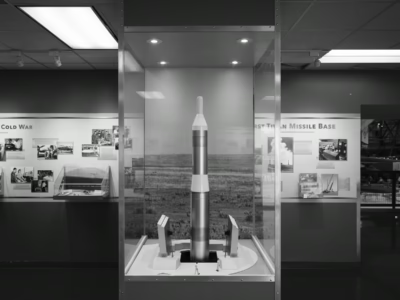Titan I
The First Silo-based US ICBM

Explosive Power
3.75 megatons
Hiroshima Equivalent Factor
250x
Dimensions
102 ft. x 10 ft.
Weight
231,790 lbs.
Range
6101 miles
Year(s)
1963–1965
Purpose
Attack Russia from US soil
About the Titan I
Forthcoming…
Gallery
Nukemap
NUKEMAP is a web-based mapping program that attempts to give the user a sense of the destructive power of nuclear weapons. It was created by Alex Wellerstein, a historian specializing in nuclear weapons (see his book on nuclear secrecy and his blog on nuclear weapons). The screenshot below shows the NUKEMAP output for this particular weapon. Click on the map to customize settings.

Videos
Click on the Play button and then the Full screen brackets on the lower right to view each video. Click on the Exit full screen cross at lower right (the “X” on a mobile device) to return.
Further Reading
- Wikipedia, SpaceRef.com, Association of Air Force Missileers
- An overview of the Titan I missile from a personal point of view. Earl See worked on the Titan I as an aeronautical engineer and makes clear he understands that the audience for which he is writing (in American Aviation Historical Society Journal, in 2014) doesn’t have much interest in missiles. (Note: I encountered much the same in my encounters with ex-military personnel at museums. There’s no romance in missiles.)
- What do you do with the old Titan I missile sites? Start by looking at the blueprints.
- Astronautix has a list of launches using the Titan I.
- The Titan I was part of a family of missiles and rockets. HistoricSpacecraft.com has a graphic comparison.
- The MilitaryStandard.com has a mini-website dedicated to the Titan I.
- Richard Walter shares a short anecdote of getting knocked down and thinking he was dead when one of the Titan I’s being tested exploded on the launchpad.
- Ellsworth Air Force Base has an overview of the Titan I with a focus on the problems with the fueling system.
- A site plan is available at the Library of Congress site.
- The Augusta Chronicle has a drone video of the Cordele Titan I and a little more history on it here, here, and here.




